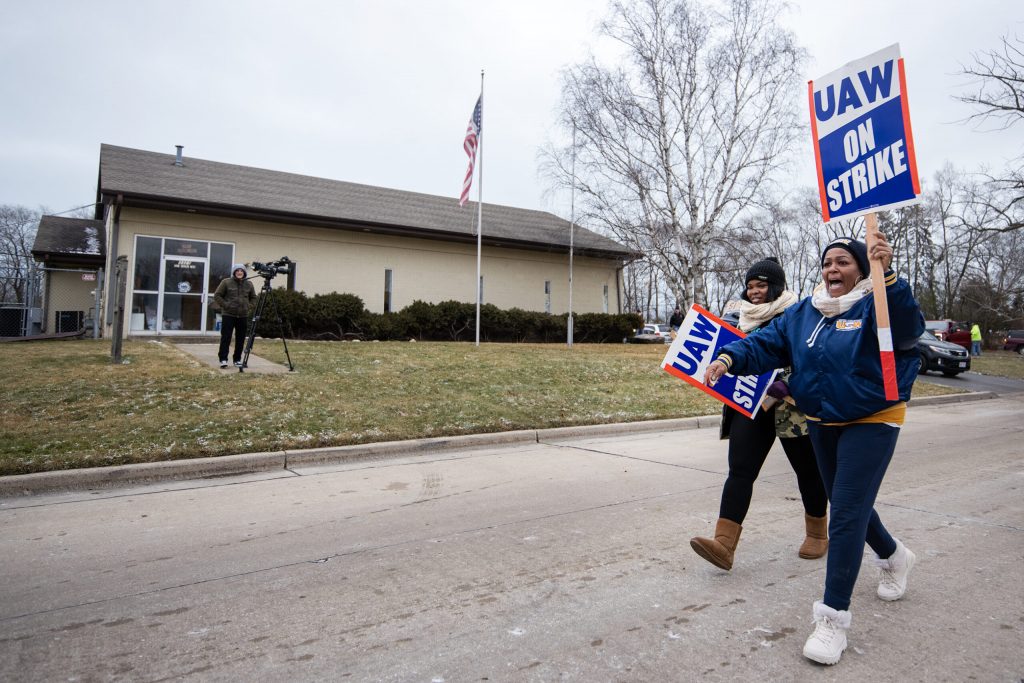State’s Union Membership Up Slightly in 2023
While rate declined nationally, it rose in Wisconsin from 7.1% of workers to 7.4%.

Attendees at the rally for striking Case truck factory workers hold signs as they exit Saturday, Dec. 17, 2022, at the United Auto Workers hall in Racine, Wis. Angela Major/WPR
After plummeting to its lowest level on record in 2022, union membership in Wisconsin rebounded slightly last year — but it’s still far lower than it was decades ago.
That’s according to data released Tuesday by the U.S. Bureau of Labor Statistics.
The estimated number of union members in the Badger State increased from roughly 187,000 in 2022 to about 204,000 last year, Bureau of Labor Statistics data shows. The unionization rate in Wisconsin also increased from 7.1 percent of workers in 2022 to 7.4 percent last year.
Wisconsin’s union gains came as the share of workers nationally who were union members fell from 10.1 percent of workers in 2022 to 10 percent last year, the lowest level since the bureau began tracking data.
While the percentage of union members fell — due to the workforce growing faster than union membership — the number of unionized workers actually increased from 14.3 million the prior year to 14.4 million.
Despite the gains in Wisconsin, 2023 saw the second-lowest number of unionized workers in the state since at least 1989, with the first-lowest in 2022, according to historical data from the Bureau of Labor Statistics.
Union membership in the state hovered between 215,000 and 230,000 from 2015 through 2021.
That makes it hard to tell if the membership gains in the new data reflect actual membership increases or a correction after an under-estimate last year, said Laura Dresser, associate director of the COWS economic think tank at the University of Wisconsin-Madison.
“You need to see multiple years of data to really know what’s going on or to be able to say, ‘Absolutely, unions are growing in this state,’” she said.
Even so, John Drew, former president of the United Auto Workers Local 72 in Kenosha, said increased construction in Wisconsin, organizing among industries that haven’t traditionally been unionized and strong public support for unions may have led to an increase in membership this year.
According to polling from Gallup, labor unions have remained overwhelmingly popular nationally, with 67 percent approval as of August 2023.
“The appetite for unionization is there amongst workers,” Drew said. “The number of people who would like to be in a union versus the people who are actually in a union, there is a huge gap there.”
Dresser and Drew pointed to state policies like Act 10 and the state’s “right to work” law as one of the reasons for the gap in sentiment and membership.
Act 10 had an especially damaging effect on public sector unions in Wisconsin, virtually ending collective bargaining for most public sector unions, Dresser said.
Nationally, Bureau of Labor Statistics data shows union membership of public sector workers is over five times higher than that of private sector workers. The agency estimates that 32.5 percent of public sector workers were union members, compared to just 6 percent in the private sector.
Before Act 10, Dresser said about 50 percent of public sector workers in Wisconsin were union members. But that number is down to about 20 percent now, she said.
“That’s a dramatic unionization loss in the state, from well above the public sector average across the nation to well below the public sector average across the nation,” she said.
While unions appeared to gain ground in Wisconsin last year, membership remains far below levels registered from 2000 to 2009, when the Bureau of Labor Statistics estimates union membership hovered between 450,000 workers and 350,000 workers.
Drew said decreases in union density have contributed to greater income inequality over time. According to the Bureau of Labor Statistics, full-time workers who were union members on average had weekly earnings roughly $173 higher than non-union workers in 2023.
Drew said last year felt like the beginning of a turning point, citing the national UAW strike as well as the high-profile writers and actors strikes.
“In 2023, unions really stood up and fought for higher wages, better working conditions (and) better benefits,” he said. “I do think those high profile battles do focus people’s attention and encourage people to want to unionize.”
Wisconsin union membership rebounded slightly in 2023 was originally published by Wisconsin Public Radio.


















